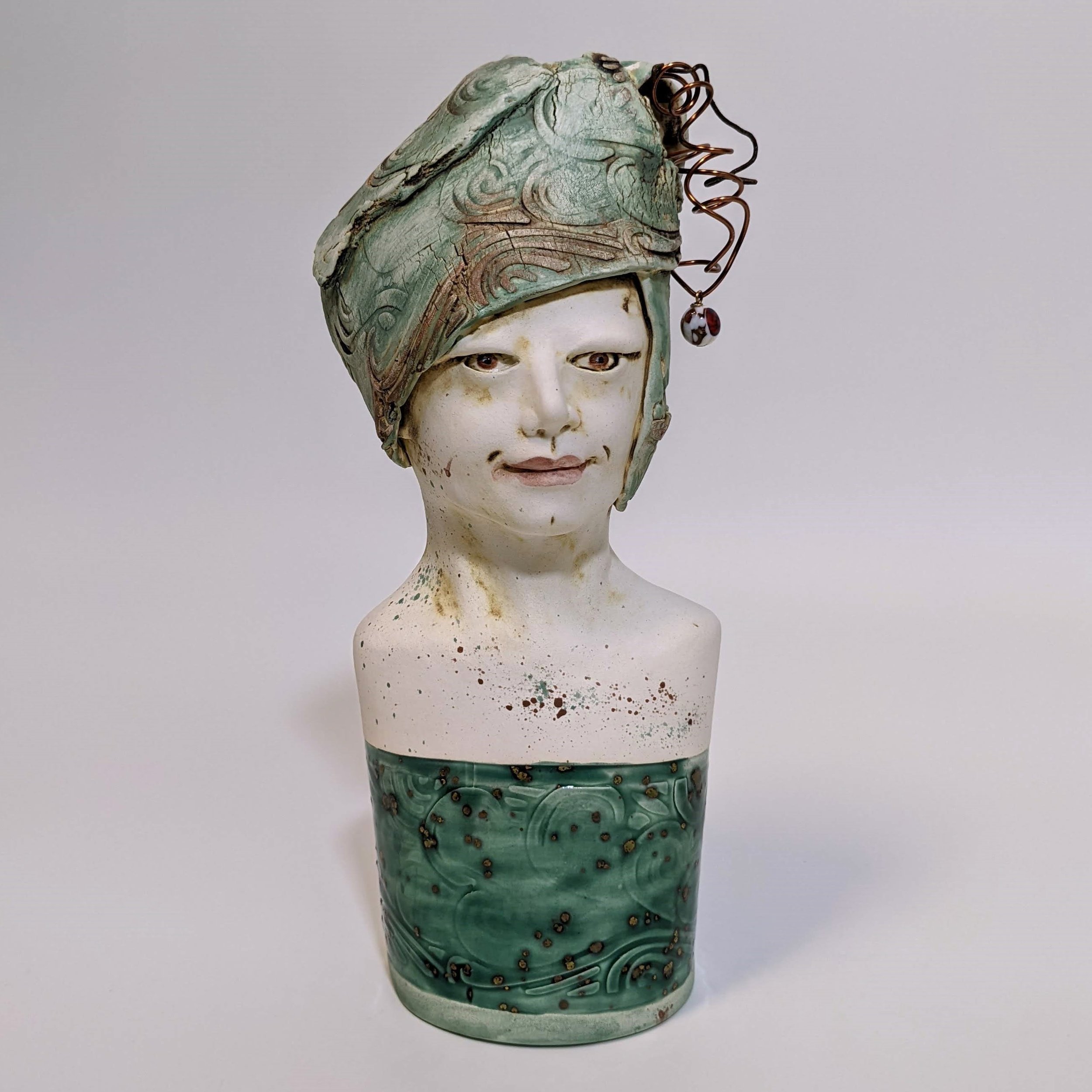We’re in the final week of our Tiny Gallery show with Lucy Bailey, a collection of dreamscapes in both 2D and 3D. Learn more about Bailey and her process below!
JASPER: Tell me a bit about where you’re from and how you came to art.
BAILEY: I grew up on Lake Murray in an idyllic setting, back when the lake was quiet and there were few residents. My parents weren’t artists, but both were creative craftsmen in their own right. As a teenager I spent every nickel at The Dutch Door craft supply store at Boozer Shopping Center and would decoupage Holly Hobbie wrapping paper and bits of wallpaper onto anything that couldn’t outrun me.
JASPER: Did you ever go to school for art?
BAILEY: My degrees are in theatre, clinical counseling, and school psychology. Anything I know about making art has been from a few master classes or through trial and error. I tend to learn what I need to know to do a particular thing.
JASPER: I know you enjoy a few different mediums, particularly clay – how did you find it?
BAILEY: Before beginning in clay, I was an admirer of all things ceramic and collected on a shoestring. In my mid-40’s I bought a bag of porcelain to try hand-building masks, unaware that porcelain was akin to marshmallow fluff. Someone at Southern Pottery set me up with a decent low-grog earthenware and building became much easier!
JASPER: Why do you keep coming back to clay?
BAILEY: There’s something viscerally satisfying about working with clay and there are endless possibilities. Yet, there are significant limitations: it’s fragile and heavy and often big and bulky. Those limitations are exasperating and, simultaneously, challenging. In my next life I hope to fall in love with creating small plastic jewelry or satin bow ties: anything small, light, and easy to ship.
JASPER: Well, I know you do some 2D work as well and recently started experimenting with scratchboards, right?
BAILEY: While clay is my go-to, drawing and making scratchboards has been a productive detour for me. My drawings are small scale and done with colored pencils and ink. The scratchboards are a thin layer of white clay covered by black ink. Compared to ceramics, which requires building time, drying time, multiple firings, etc., drawing and scratchboards are more immediately satisfying, and I can pivot to them while ceramic pieces are in one of those various stages.
JASPER: In 2 and 3D you make a lot of fun, expressive faces. Have you always been drawn to faces?
BAILEY: We are hard-wired visually to seek out and identify faces. Figurative work is definitely what I’m most drawn to, with a focus on busts and faces/masks. In terms of sculpting, faces are fickle. Early on a face will have a particular look and later in the process it has adopted a different quality.
JASPER: Do you find that some images repeat themselves?
BAILEY: There are certain ideas or imagery I’ll play with for a while then move on to another, and usually circle back to an earlier idea again later. A small skull stamp is commonly found lurking somewhere in my work as a memento mori. There’s a series of what I think of as coins from doodles back in college used in many pieces. Lately I’ve been in a moon phase (pun intended) crossing over from mixed-media-plus-ceramic wall pieces to pendants. For me it’s not about striving to conceive of an image because the images are finding me.
JASPER: How long does it usually take you to feel “finished” with a piece?
BAILEY: Mary Ann Haven recently told me that older work should just be considered raw material and I love this conceptualization. With ceramics there’s only so much you can do once a piece is fired, but there are still many post-firing possibilities. I have a couple of larger (for me) pieces from a show at Stormwater Studios with K. Wayne Thornley last May and those will be reworked soon by adding wire and photographs.
JASPER: Tell me about this show specifically. What kind of pieces have you decided to show, and why?
BAILEY: The Tiny Gallery grouping is all connected to clay, even the scratchboards. It felt important to have a couple options for small-scale figures, so I made the three moon cap figures and the three pieces with glaze bands around the base. While glazes don’t feature heavily in my work, this color is really perfect for the sea tides motif. I wanted to include wall-mounted figurative works, so I created several new masks and included two older ones as well. The (imagined) Lover’s Eye pendants (which are graphite drawings on earthenware) and scratchboards are included to pull 2D into the mix.
JASPER: What’s in the future for you?
BAILEY: A big change for me is coming up at the end of June when I retire from my day job! I have just started working on a series combining vintage (think late 1800s-mid 1900s) children’s clothing with photographs and other mixed medium—no ceramics involved. There’s also a nascent project integrating larger pieces of wood into the design. And I want to return to some very early ideas and explore them in more depth.
Some of the new work will be ready this November when K. Wayne Thornley and I host our second annual Art on the Pond open studio, so we hope everyone will come see us then.
JASPER: Finally, where can we find your work?
BAILEY: Newer work is on Instagram and Facebook (both @lucybaileyclay). At this point my website (http://www.lucybaileyclay.com) is an archive but it may get revived soon. My business name is officially Lucy Bailey Studio.
To see Bailey’s effervescent scratchboards dancing with figures and faces and her delicate yet striking sculptures each with their own expressive quirks, go to Jasper’s virtual gallery: https://the-jasper-project.square.site/tiny-gallery




